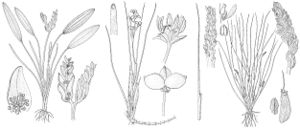Aponogetonaceae
Herbs, perennial, rhizomatous, caulescent; turions absent. Leaves alternate, floating [submersed], petiolate [sessile]; sheath not persisting longer than blade, not leaving circular scar when shed, not ligulate, not auriculate; blade ovate to narrowly lanceolate [linear]; intravaginal squamules (i.e., minute appressed, planate trichomes attached at basal edge) scales, more than 2. Inflorescences terminal, spikes, subtended by spathe, pedunculate; peduncle following fertilization not elongating, not spiraling. Flowers bisexual [unisexual]; subtending bracts absent; perianth present [absent]; tepals 1 [–6]; stamens 6–18 [–50] in 2–3 [–4] series, not epitepalous; anthers distinct, dehiscing longitudinally; pollen ellipsoid; pistils 2–6 [–9], distinct, not stipitate; ovules basal-marginal, anatropous. Fruits follicles. Seeds 4; embryo straight.
Distribution
North America, s Africa, and tropical regions of Eastern Hemisphere
Discussion
Genera 1, species 5247 (1 genus, 1 species in the flora).
Selected References
Lower Taxa
Illustrations
| Family ⠉ | Taxon | Illustrator ⠉ | |
|---|---|---|---|
 | Scheuchzeriaceae Aponogetonaceae Juncaginaceae | Scheuchzeria palustris Aponogeton distachyos Lilaea scilloides | John Myers John Myers John Myers |
"not elongating" is not a number.